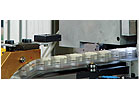
InterControl integrated the In-Sight 5400 vision system directly into the automated assembly machine that produces the temperature controllers for domestic appliances. Photo courtesy Cognex
Recently, one of the company’s temperature controllers for the domestic appliance industry needed to undergo a 100 percent quality inspection. The controller is comprised of a ceramic base with a bimetal mechanism and different connection and fastening options.
The goal of inspection was two-fold: detect all faults in each controller and ensure that each component’s ceramic base is crack-free. The challenges of inspection were also two-fold. One was that the company processes approximately 50 million ceramic bases per year, and the various base components amount to a total of 200 different controller variants. Another was that the controller is manufactured in a fully automated process.
To meet these challenges, InterControl sought input from its vision vendor, 3D Motion. 3D recommended using the In-Sight 5400 vision system by Cognex. Because the In-Sight 5400 is compact, InterControl was able to integrate it directly into the automated assembly machine that produces the controllers.
The company adopted an object-oriented approach with the vision system, meaning that only the base plate is scanned and all test programs are then adapted to it. This greatly simplifies the administration of test programs, reduces operating costs and improves system flexibility.
In addition, the object-oriented structure of the test programs enables approximately 150 different temperature controller variants to be stored directly in the In-Sight vision sensor. These variants can be automatically called up when needed, enabling InterControl to inspect each individual test part for an entire sequence of fault characteristics.
The inspection station has an image-processing cycle time of 0.3 second, enabling it to check 80 components per minute. Each individual temperature controller is inspected for defects such as ceramic separation, cracks and angle of the contacts. Specific zones in the lateral supports are also inspected, along with connection geometry, base plate hole diameters, flange type and color-coding on the ceramic part.
Prior to using vision inspection, changes in batch sizes often resulted in one or two incorrect parts being delivered. Now, the vision system immediately detects the geometry of a part and immediately rejects faulty ones.
The vision system also eliminated the problem of good parts being detected as faulty. Such parts were merely discolored due to dripping oil. Now, the assembly machine stops automatically once three faulty parts pass through the test system in succession. To ensure a smooth production process, fault sources are statistically recorded and analyzed, and counter measures are implemented.
Before implementing vision inspection, the fault rate of the controller was low at 25 to 50 parts per million. The fault rate has decreased even further. As a result, InterControl has incorporated vision systems into three additional automated production units, says Peter Wild, operations manager at InterControl.
For more information on vision inspection systems, call 508-650-3000 or visit www.cognex.com.



